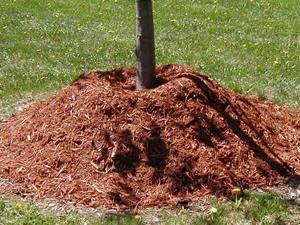Mulching

If Some Mulch is Good, Is More Mulch Better?
Landscape professionals frequently tout the benefits of mulching around trees, and rightly so. Mulching around trees reduces soil compaction, suppresses weed growth, conserves moisture and eliminates the possibility of damaging the tree or maintenance equipment when working near the tree. Mulch, instead of grass, at the base of the tree eliminates the competition for nutrients and moisture. Unfortunately, some maintenance contractors apply excessive, sometimes enormous, amounts of mulch around trunks – and the practice just seems to be getting more common.
Listed below are some of the problems associated with “over-mulching”:
- Oxygen deprivation of shallow roots leads to decline of the root system.
- Phloem death (due to lack of oxygen exchange) occurs in the buried portions of the trunk.
- Increased risk of fungal and bacterial infections due to constant moisture around the trunk.
- Excessive heat from decomposition of the mulch can directly kill stem and trunk tissue.
- Mulch can adversely affect the pH of the soil, depending on the material used.
- Deep mulch provides hiding places for rodents that can chew extensively on the bark around the trunk, sometimes completely girdling trees.
Mulch can be applied just about any time of the year when trees and shrubs are being planted. The best time to apply mulch in established bed areas, however, would be in mid-spring when soil temperature has warmed up enough for sufficient root growth. Mulch should be applied 2-4 inches in depth over relatively clean, weed-free soils. No more than 2 inches if soil is not well drained; up to 4 inches if drainage is good. More finely textured mulches should be no thicker than 1 or 2 inches. This is because fine-textured materials allow less oxygen penetration than coarser materials (such as nuggets). Never pile mulch more than 4 inches high. Do not allow mulch to touch tree trunks; keep mulch 3-5 inches away from trunks of young trees and 8-12 inches from trunks of older specimens.
If you inherit a heavily mulched tree, inspect the mulch’s depth; if the root collar (the junction between the stem and the roots) is buried, excavate around the tree until the collar is exposed. This will allow the collar to dry out and can rapidly improve the vigor and appearance of trees suffering due to mulch-related problems.

